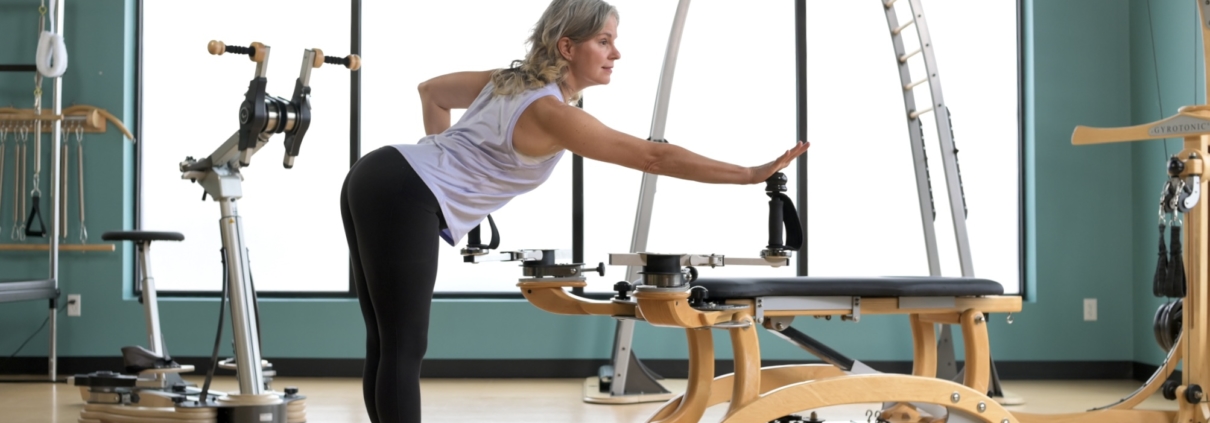Mindful movement habits to support our mental well-being
Confession: I am a movement nerd. But developing a mindful movement practice doesn’t mean you have to be too! I’ve spent decades thinking about physical movement and how to help more people incorporate it into their daily lives in positive, productive ways. Whether I’m teaching a Pilates class, helping people combat the cumulative effects of sitting at a computer all day, or working on my own GYROTONIC® practice, my focus is always on moving purposefully and mindfully. But what the heck does that mean? What does mindfulness look like when we connect it to physical activity and why should we care?
Mindfulness is a friendly conversation between your mind and body
Last year, I read a great article by Elizabeth Yuko that outlines why mindfulness is so often misunderstood and how she learned to use it to alleviate her own stress and anxiety. Yuko highlights the fact that mindfulness, as it’s explained by psychologists, is about observing your thoughts and feelings in an objective way. It’s not about zoning out and clearing your mind to calm yourself, but rather it’s a way of using your senses to notice the things around you, which in turn helps calm your mind and body.
This idea of “noticing” and understanding why it matters is critical to mindfulness and creating successful movement habits. Noticing the sensations within our own bodies is called interoception. On a basic level, it’s how our bodies and brains speak to one another. It’s how we know when we’re tired, hungry or thirsty, or when we need to pee. However, learning to listen to our bodies’ messages can also help us develop healthy movement and exercise habits, reduce stress, and improve our overall well-being.
So many people I’ve worked with over the years believe that starting healthy exercise and movement routines means finding the time, purchasing the right equipment, and/or getting the motivation to start. But I think the first and most challenging step is practicing mindfulness so that you can better connect how you feel with how you move.
Noticing which activities make us feel better
Take a moment to think about the types of activities that you enjoy and find yourself purposefully seeking out. Maybe it’s getting up early in the morning when it’s still cold and a little dark to walk your dog. Perhaps it’s packing up your laptop and going to your favorite coffee shop to work for the afternoon. Or maybe it’s cooking a big meal in the evening for your family. For me, it’s heading out for a walk in the woods behind my house with my dogs.
Now, think about why you enjoy those things and how you feel. Maybe getting out for a walk early in the morning is when the sound of the birds is the loudest for you (or the sound of traffic the quietest) and feeling the cold on your face or legs makes your skin tingle and wakes you up. Is your favorite coffee shop your favorite because of how it smells, sounds, and appears inside? Does that collection of physical stimuli re-energize you and make you feel ready to work for another couple of hours? Does cooking in your kitchen (the feel of different ingredients in your hands, the smell of spices or herbs, the heat from a warm stove or oven) change how you feel physically and mentally?
Creating mindful movement routines to improve well-being
Noticing how you feel when you engage in different activities is the key to starting and sustaining healthy physical movement routines, too. But here’s the key: Learning to notice how we feel takes practice. Yes, really.
The more often we do something, the more thoughtfully and deeply we’re able to engage in it. It’s just like exercising a muscle. The first time you try to do squats for example, you might be completely focused on trying to learn the correct form from your trainer, that you can’t even begin to think about what your muscles are doing or how they should feel. But the more you do it, the easier it is to start noticing what it should feel like.
The same thing happens in our Pilates classes at MOVE Wellness. When someone is new to Pilates, just learning to notice how their body and breath feel when the lumbar spine moves from a neutral to imprint position and back again takes practice. The more we practice, the easier it is to be mindful of what we’re doing, how we feel when we’re doing it, and what to do next to build on that positive movement. As we do this, our awareness increases and works to counteract any tension or stress.
Below are a few simple tips for learning to move more mindfully:
Move more.
(Thank you, Captain Obvious!) Ok, so when I say move more, what I’m really talking about is intentionally incorporating physical movement opportunities into your day. Set an alarm on your phone for certain times of the day that signal it’s time to get up and go out for a 30-minute walk. If you don’t have 30 minutes, go for 10 or 15. Even getting up from your computer once every hour to take a couple laps around your apartment or yard can become an essential well-being routine. If you’re injured or unable to walk, schedule regular opportunities to sit somewhere, breathe deeply, and gently stretch your limbs and mobilize your joints. Try midday or hourly shoulder, wrist and ankle circles.
Move in a way that you enjoy.
I will continue to shout this mantra from the highest mountain tops. If you want to make physical movement a part of your routine, you need to find a way of moving that you enjoy enough to do regularly. And start small. If you’re a walker or jogger, try walking or jogging once or twice a day for even just 10 or 15 minutes. If you love doing yard work or gardening, schedule time each day to move that way. If you can’t stand the idea of lifting weights or going to the gym, but love kicking a soccer ball around or dancing with friends, do that regularly. Don’t think “workout.” Think movement. If you’re going to learn to notice how you feel when moving, it has to be routine and it has to be enjoyable.
Move with your breath.
Practicing breathing can feel silly and unproductive if you’ve never done it before. But learning to notice how our breath moves through our bodies is the easiest way to practice mindful movement when we’re new to it. Focusing our attention on breathing slows everything else down, which does wonders for reducing physical tension and racing thoughts that produce anxiety. (Ever told a friend or child to “slow down and take a breath” before? What we really mean is, take a breath so you can slow down.)
Find regular times during the day to sit upright (either on a chair or stool with feet flat on the floor OR on a mat or cushion with your legs positioned however is most comfortable for you). Then, with eyes closed or just softly gazing down, calmly breathe in for two or three counts, and then gently exhale out for five or six counts. And don’t worry about the counts! Whatever feels natural is what you should do. As you breathe, let your mind notice how your lower back, belly, ribs, and shoulders move and feel on the inhale. Notice how they change on the exhale.
Noticing our breathing in this way accomplishes two critical self-regulatory activities in our bodies: 1) It stimulates the vagus nerve, which helps regulate our nervous systems and ultimately our stress levels, and 2) it encourages the organic function of our musculoskeletal anatomy including our deep abdominal and pelvic floor muscles.
Getting the professional help and mental health resources you need
No matter how you start your mindful movement journey, feeling safe and supported while you do it is essential. If using free online movement resources or some of the simple tips above leaves you feeling intimidated or uncertain, reach out to a movement professional for help.
If you’re facing some major life challenges right now that are leaving you feeling unmotivated or overwhelmed, seek out professional resources and ask for the support that you need. St. Joseph Mercy Behavioral Health provides services that can address a variety of mental health needs.
Most important, remember that being mindful is about noticing how you feel without passing judgment on yourself or your feelings.

